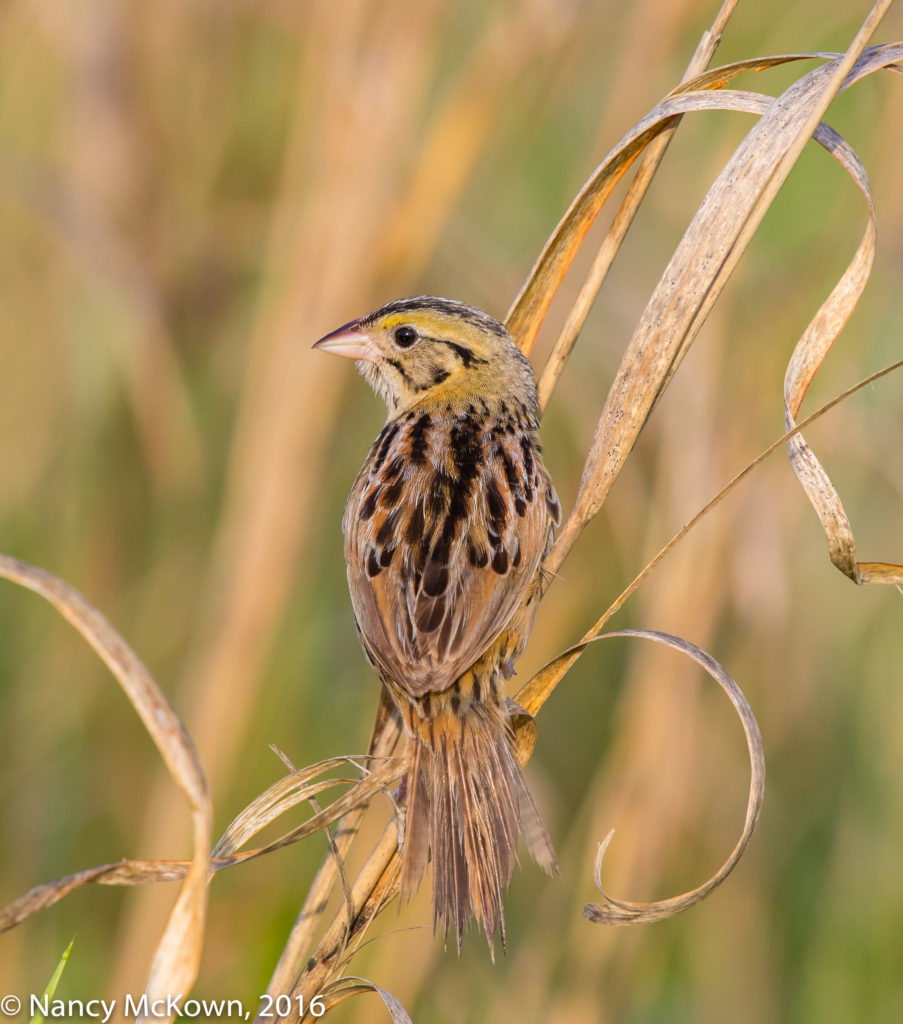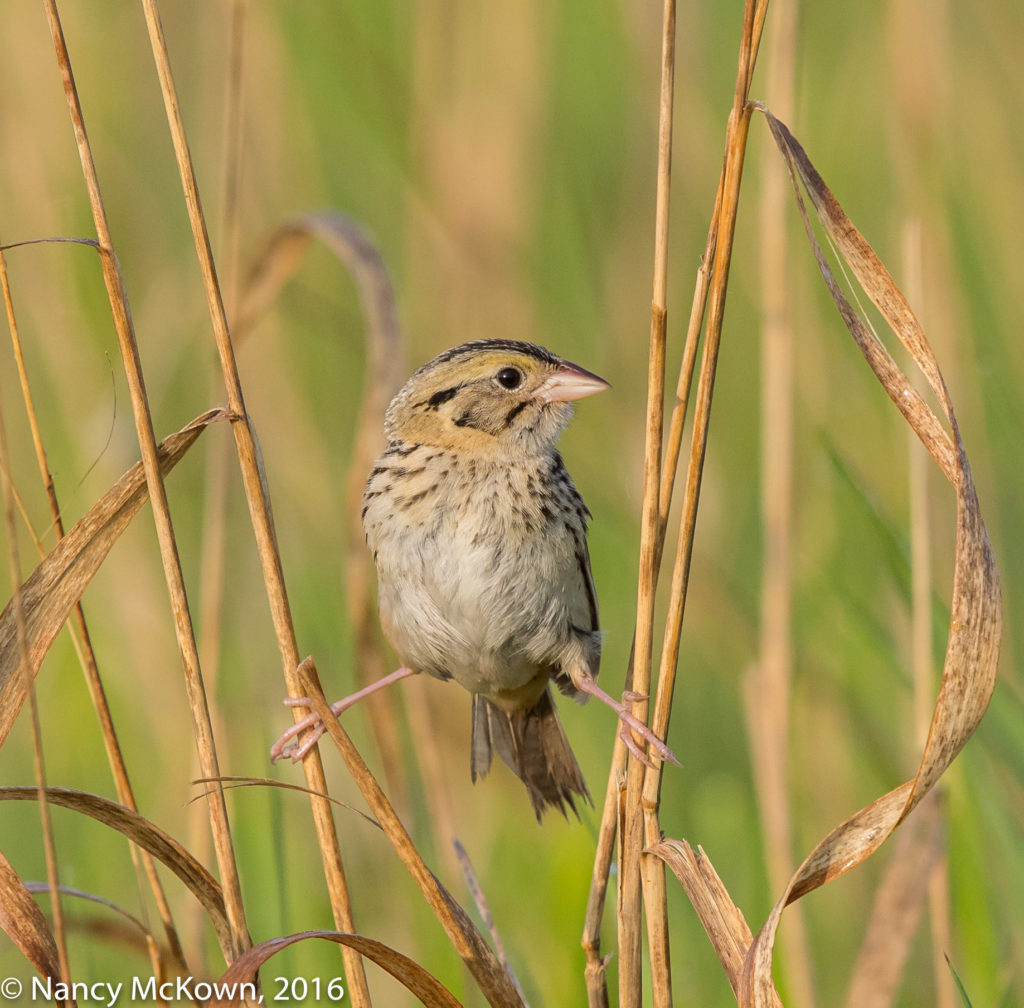Photographing a Henslow Sparrow
We arrived at 7:00 am – long past the late May sunrise. Dew drops on the long gold and green grasses sparkled in the morning sunlight. Stinking of bug repellent, we parked the cars on the side of the road, grabbed our camera gear and followed our friend down and up through the wet ditch, then trekked onward through the fields toward the grasslands where he had spotted a couple Henslow Sparrows. Careful to stay on the field path so as not to disturb the nests in the grasses, I set up my camera, 500mm lens with 1.4 extender.

ISO800; f/9; 1/1000 Second
NOTE: I had thought my Rolly cart would be useful to haul camera equipment on this trek, but after learning about the saturated fields and deep ditches, I was convinced otherwise. Note #2: Cradled in my arms, the camera gear stayed dry, but my cotton jeans were soaking wet minutes into this adventure. I really need to get those multi pocketed, bug resistant, quick drying nylon trail pants.

ISO800; f/9; 1/800 Second
Two Extroverted Henslows
The Henslow is a strikingly handsome sparrow. His back and breast feathers sport black teardrop shaped patterns atop a background of chestnut brown. His heavy beak protrudes prominently on his large, somewhat flat head. Thick black lines accenting his dark eyes blaze across his yellow face– with one black stripe extending down the center of his face and onto his upper beak. His uneven, straggly tail feathers fanned out when he perched.
According to my birding manual, the Henslow Sparrow lurks unseen in the tangled grasses and often slips away undetected if an intruder appears. This was not our experience. We saw at least two extroverted and spunky males in the distant grasses, each carving out a smallish territory and boldly flying from leaf to branch to defend it. We heard their lusty songs before we parked, and they sang vigorously atop grasses and raspberry stalks the whole time we photographed them.
Beauty Enhanced in Its Element
So often in bird photography, the image background, though pertinent because it is part of the bird’s natural environment, is unmanageable, distracting, overbearing or sadly detrimental to the overall artistic layout of the image. This is especially true in warbler habitats.
A Ready Made Flawless Bokeh
A grassy field in early morning is different. If the field is full of tall and wild golden grasses and the sun is low in the sky (and you make sure that the skyline is not in the viewfinder) it’s hard not to create a fabulous Bokeh infused with soft and seamless shades of glowing gold.
Light and Wind
Bright light is essential. If the morning sun is heavily filtered, you won’t see the background vibrancy in your images. A spirited wind buffeting the grasses adds more dimension because the background blur becomes more curvy. Wind swept grasses fashion their own animated, artful flow that express themselves in complex, undulating seamless patterns once the shutter is released.
A soft and gentle breeze can change instantaneously to a vigorous surge and compromise sharp focus. I had to be watchful of my exposure settings. NOTE: Instead of being displaced by the wind, little songbirds are generally agile enough to to balance their weight, go with the flow, and hold on.
Adjusting Camera Position
Framing an authentic and beautiful image background was not a problem in the wind blown grassy fields where these Henslow Sparrows nest. The whole time we were there, I could easily move the camera and tripod, enabling me to not only better track the sparrows’ movements, but also recompose the scene. I was able to change out the green and gold background colors and the lines and curves of the grasses and branches around which the sparrows perched. NOTE: Repositioning the camera also helps when the photographer wants to adjust exposure settings, avoid lens flare, or take advantage of different types of directional lighting. The freedom to frequently recompose the scene during a bird photography shoot is uncommon, but can produce a collection of vibrant image backgrounds.

ISO1000; f/9; 1/1000 Second
On the Decline
Everything came together that morning- creating perfect conditions in which to photograph this lovely Sparrow. Sadly, Federal and State agencies report that the Henslow Sparrows are hard to find and their numbers are on the decline due to the loss and/or fragmentation of their breeding habitat; open field prairie filled with dense grassland. More information on the Henslow can be found at this link.









Nancy,
I enjoyed the blog today. The unusual picture of the sparrow “doing the splits” on the reeds made me laugh. The other two pictures were quite beautiful. The text was interesting and fun to read.
I look forward to your blog every week. Keep up the good work!